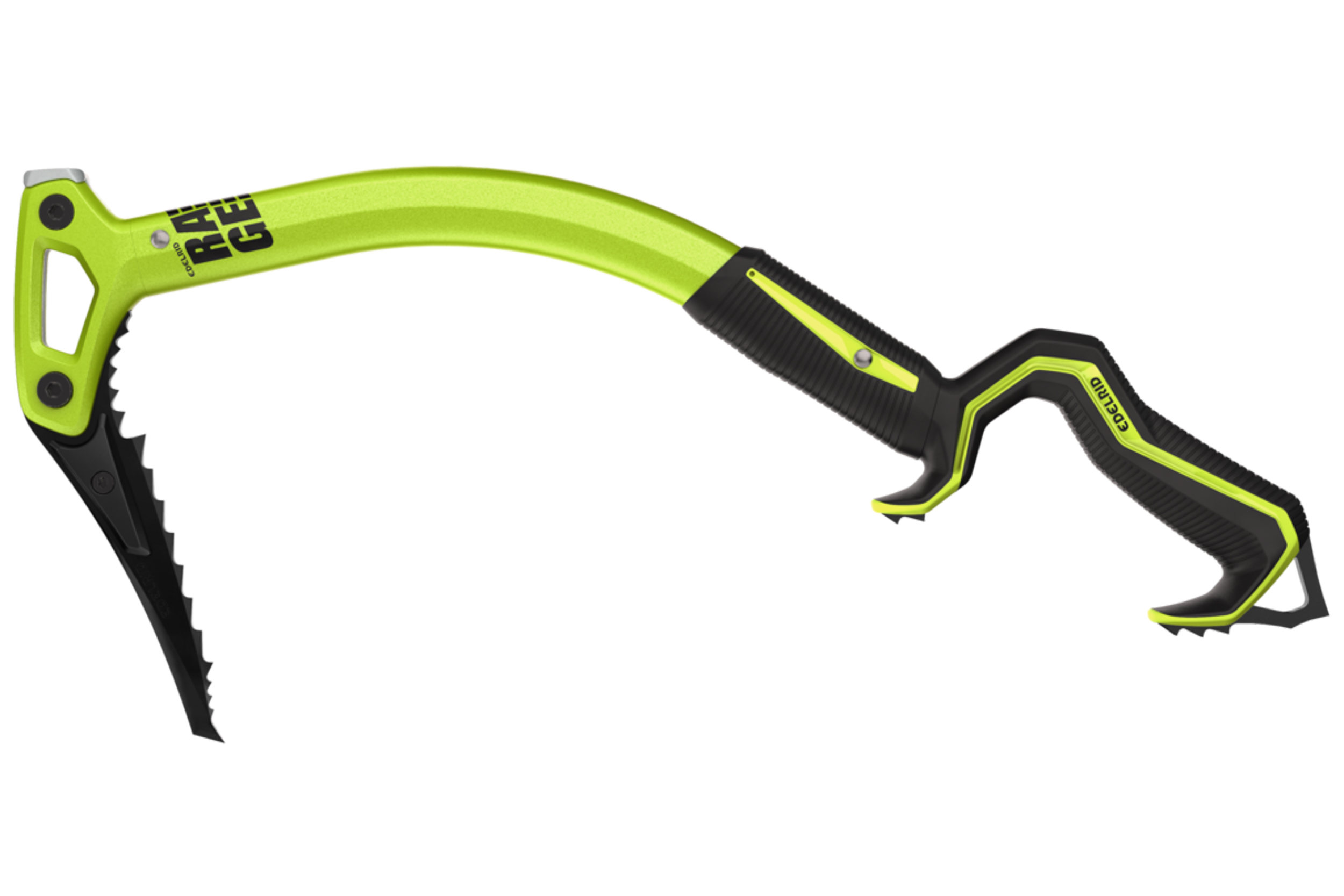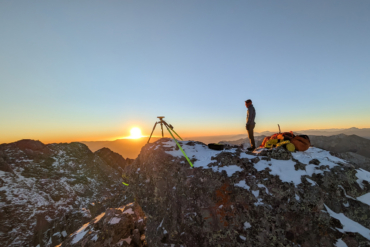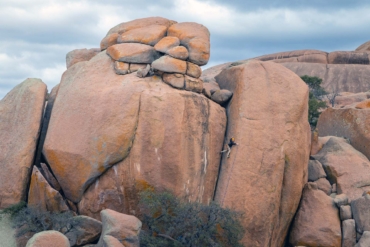The Edelrid Rage ice axe got a much-awaited makeover after more than a decade on European shelves. I was keen to try the new version, which is available in the U.S., on a recent trip to Alaska. The tools certainly look the part, with eye-catching green anodization and very ergonomic-looking handles.
But looks don’t matter when you’re high above terra firma, gripped out of your mind, with forearms ablaze. Ice axes need to perform as expected while climbing. There is little room for unexpected or sub-par performance, especially on the sharp end.
So, I’m very particular about how ice axes feel and perform. This is the lens through which I viewed the new Edelrid Rage as my team and I searched and found frozen multipitch challenges in the great state of Alaska.
I tested the Edelrid Rage ice axes on 400- to 600-foot-tall waterfall ice in the backcountry surrounding Palmer and Valdez over a weeklong excursion in February. The routes were at or near my limit of ice-climbing ability. This season in Alaska was particularly snowy and cold, so the ice was often brittle, but the routes were solid. Temperatures ranged from 0 to just over 10 degrees.
In short: The Edelrid Rage ice axe (MSRP $280) was a sports car in a field of sport utility rigs. The steeper and more convoluted the routes, the better the tool performed. The weight, geometry, pick, and other features of the Rage made it most suitable for more difficult routes for climbers with the appropriate abilities. When the going was steep, the Rage, well, raged. But it was on the heavy side for the tallest routes furthest from the trailhead.
- Shaft material: Aluminum
- Grip material: TPU
- Available picks: Mixed, Ice
- Available accessories: Hammer, mini-hammer, adze
- Certification: EN 13089 Type 2
Pros
- Good swing weight for hard ice
- Excellent geometry and ergonomics for steep ice
- Superb grip adhesion
- Robust spike
Cons
- On the heavy side for long approaches or extremely tall routes
Edelrid Rage First Impressions
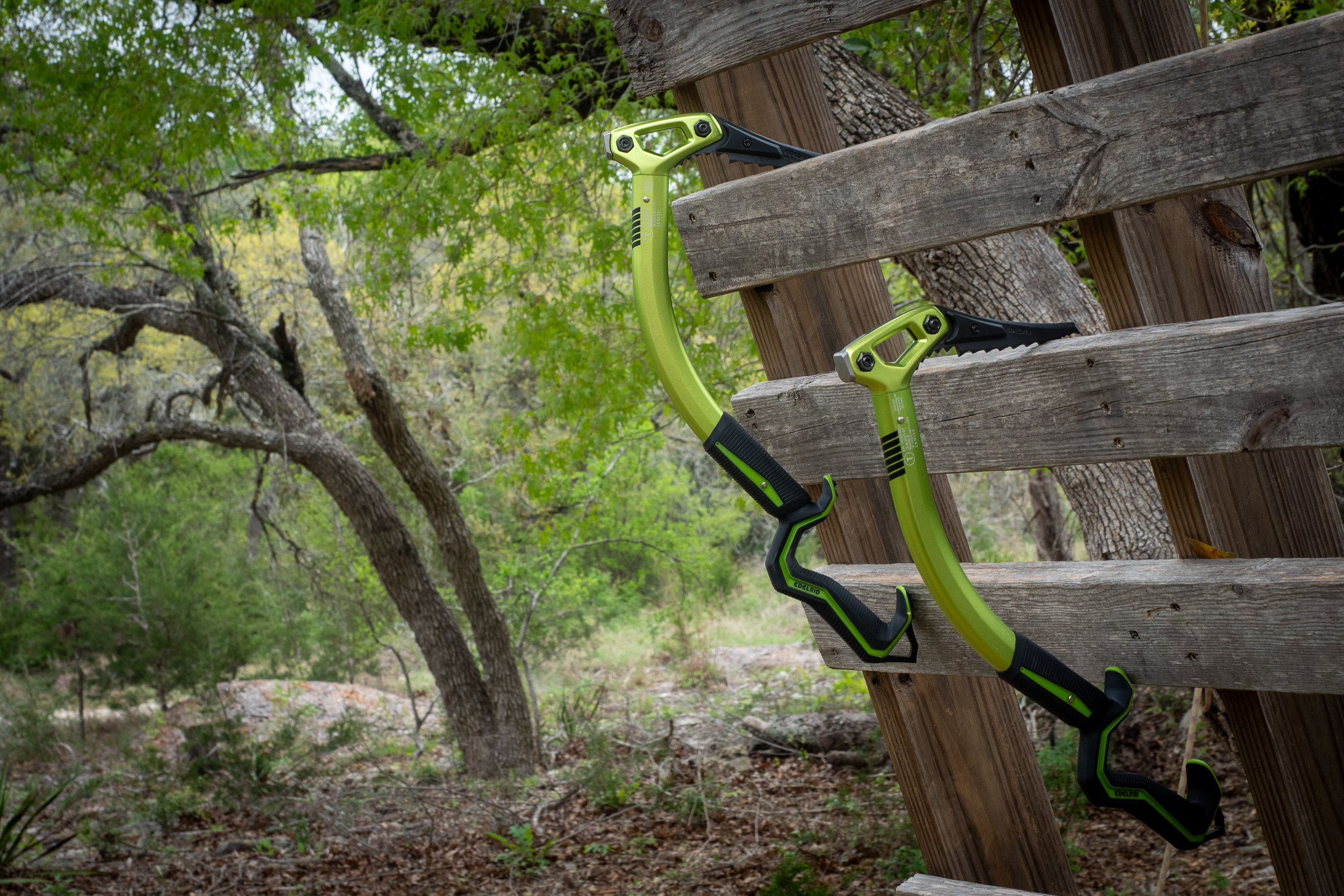
When I unboxed the Edelrid Rage ice axe, the relative heft was apparent compared to other tools I’ve used for big ice in Alaska. At a verified 1 pound, 8 ounces with the included mixed pick, head weight, and micro hammer, it’s quite a bit heavier than the featherweight Trango Kestrel (1 pound, 3 ounces with head weight). However, the weight is comparable to that of the Black Diamond Reactor, which tips the scales at 1 pound, 6 ounces without a head weight or hammer.
The geometry of the shaft is aggressive and gave me the impression that the ice tool would serve me well on routes at and above WI5. The angles of both the shaft and TPU-coated ergonomic main grip looked excellent for vertical terrain or for reaching over bulges and mushrooms.
The handle, by far, was the grippiest feeling I’ve tried to date and felt like the correct size for my gloved, medium-sized paw. The pinky rest on both the main and secondary upper grip looked large enough for even the thickest gloves. The Edelrid Rage ships with plastic spacers that shorten the grip for those with smaller hands, but I didn’t use them.
Finally, the bottom spike didn’t look like an afterthought. It is substantial; indeed, the clip-in hole is rated to a full 8 kN load. This might come in handy if the Rage is employed as an anchor.
I swapped the standard mixed pick for an ice-specific version before heading to Alaska. Also, Edelrid offers a larger hammer and adze for the Rage.
Edelrid Rage Ice Axe on Route

Grip and Swing Ergonomics
Gripping the handles of the Edelrid Rage for the first time in Alaska made me utter, “Ah, yeah! ” The aggressively textured TPU adhered ferociously to my climbing gloves.
In addition to the tacky feel at 0 degrees, the diameter of the grip, which seemed small to my climbing partners initially, fit my gloved hands perfectly. I appreciated that the secondary rubber upper grip had the same aggressive pattern molded into and it was the same size.
The weather had been very cold before my arrival, so the ice was harder and more brittle than on any of my prior forays into Alaska. The Edelrid Rage pick with weights had a heavier-feeling swing than any of my other ice tools. But this was good for how hard the ice was.
Yes, the ice axes weighed more than most I haul into the backcountry, so I spent a few more calories on long approaches. However, swinging into the unrelenting ice required much less effort than with lighter options.
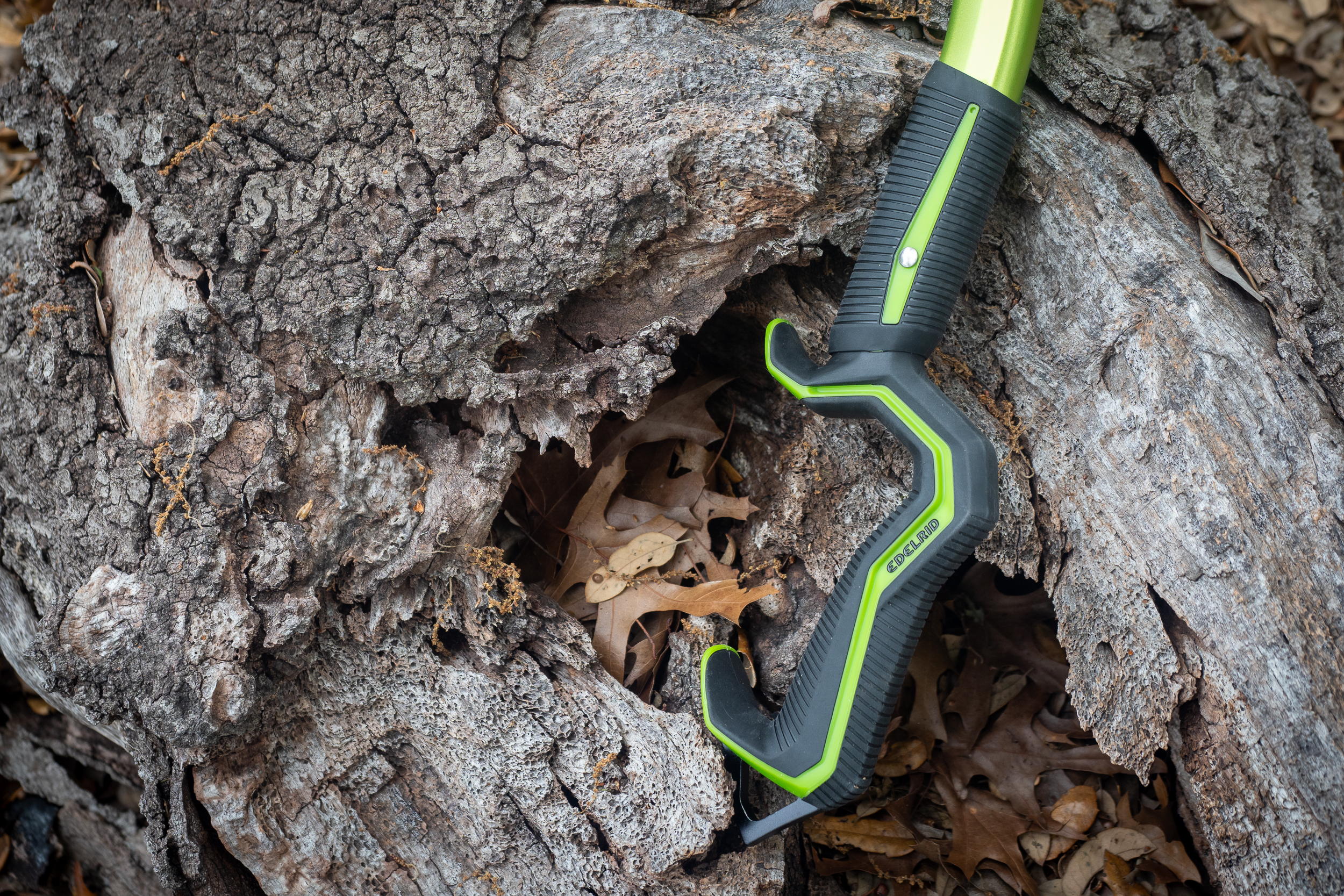
Swing after swing, the Edelrid Rage delivered solid sticks. I generated force early and let the swing weight carry me through the final wrist flick. This final stage of the swing was made almost effortless by the way the grip is oriented and shaped. The tool rotated cleanly and naturally in my relaxed hand as the head followed through to impact the ice.
The head consistently resisted twisting on impact. And the tool’s geometry allowed for natural wrist, elbow, and shoulder angles throughout the swing. Even if I felt a minor perturbation of the tool upon impact, the result was easily mitigated with slight adjustments. This wasn’t a flyweight, carbon-shafted ice tool that required much attention and effort if the pick didn’t dive straight in.
The Ederid Rage mitigated harsh vibrations from hard ice or bottoming out well. It wasn’t quite on par with carbon-shafted ice axes, but it was better than other aluminum-shafted tools I’ve used. I credit much of the damping ability to the construction of the handle.
Ice Pick Performance
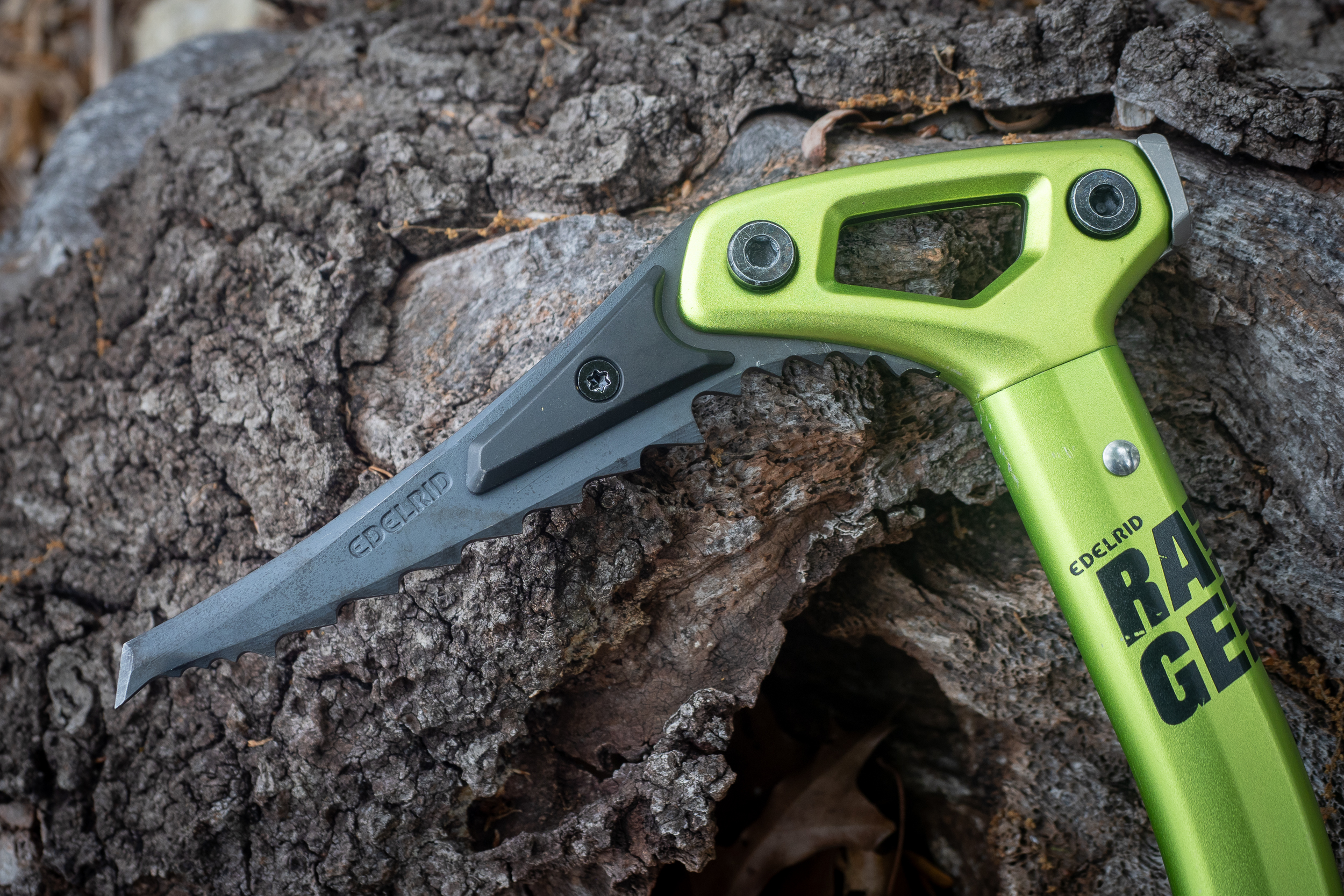
The ice pick for the Rage was incredible. The ice conditions were challenging; the ice was hard and often formed lenses that wanted to pop off on the first swing. And if the ice wasn’t brittle, it was hard as stone. But the Rage ice pick penetrated the diamond-like ice cleanly and rarely did I have to take multiple swings.
And for how often I hit lenses, I rarely popped one off. The pick would penetrate and the typical white, circular lens would become visible. But then the lens was adhered enough to use. This is a nuanced feel for sure, but I was certain that the pick on the Rage could penetrate with less collateral damage than others I was testing simultaneously.
As with any other ice pick, I touched up the top of the pick’s point with a file. I found the Edelrid ice pick to be amazingly nonstick. The only issues arose when I misjudged the ice and drove the axe like the Hulk.
When the ice was softer or on the verge of rotten, I had to throttle down my swing or else I could drive the pick in too far. Once I got the feel, it wasn’t a problem.
In a similar fashion, on snowy terrain, compared to flyweight tools, I didn’t have to plunge the spike and handle with as much force. The Rage penetrated packed or crusty snow with little effort.
Other Edelrid Rage Attributes
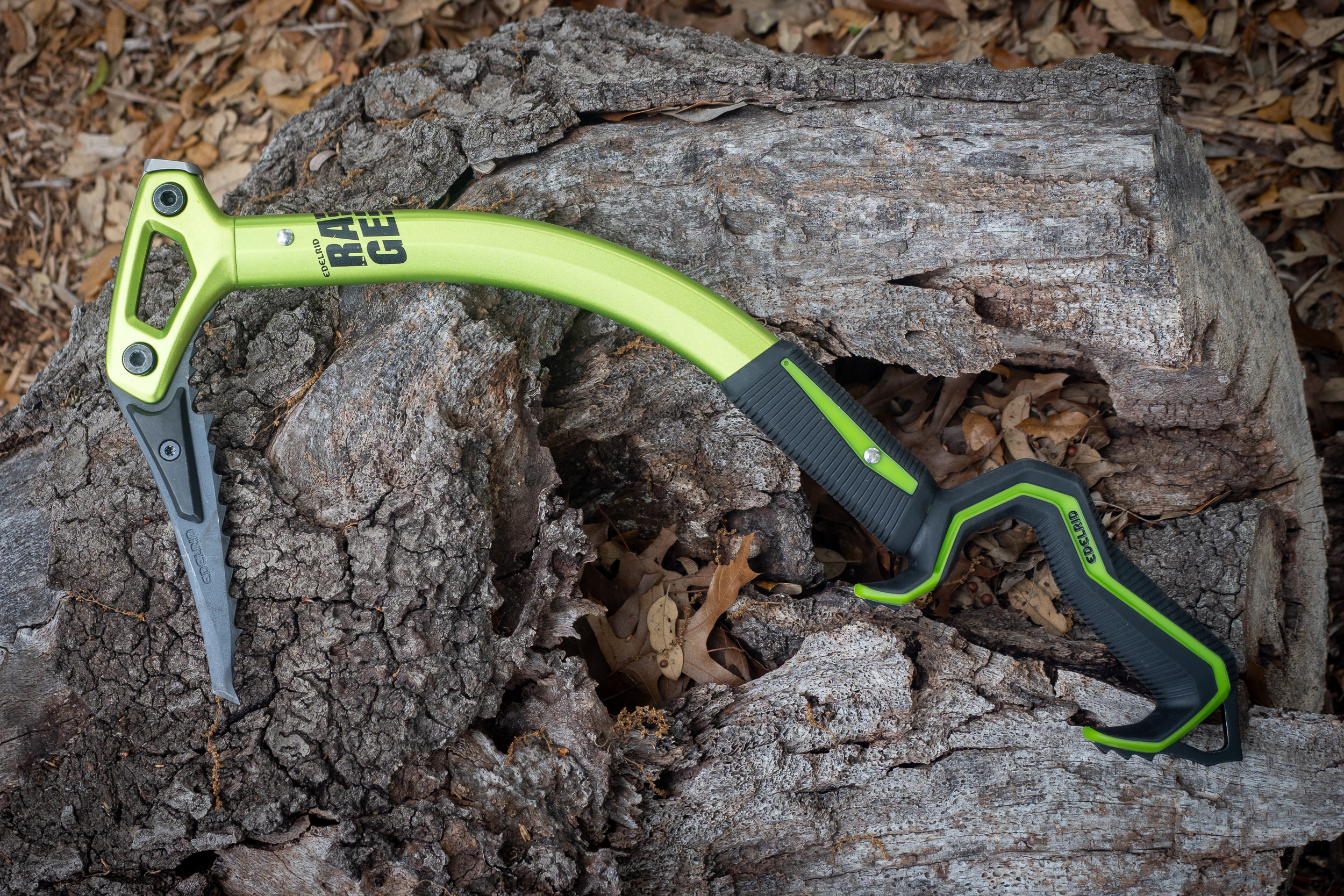
I appreciated the large hole in the head of the Rage as the tools easily fed into my ice clippers for the rappels. Ditto for the hole in the spike. And speaking of the spike, Edelrid made it burly. Thick and larger than others, I didn’t worry about it when driving the shaft into snow and potentially bottoming out on ice, rock, or frozen dirt.
Over the course of one 400-foot route that took us more than 6 hours to decipher, I didn’t miss a beat with the Edelrid Rage until the end of the last pitch. This was our second, long day on, and fatigue was setting in. This is when I felt the relative heft of the tools.
For about half a rope length, I wanted my lighter tools. I had to buckle down and concentrate harder to initiate my swings correctly. And I wanted my entire system to be lighter. For this reason, I feel that the Edelrid Rage would be better suited to sportier ice cragging.
Final Thoughts on the Edelrid Rage

The Edelrid Rage ice axe excelled on more difficult, steeper pitches on Alaskan ice. The geometry, swing weight, grip, and general ergonomics suited me well when the ice was vertical and in my face. The ice pick penetrated super-hard ice cleanly, often eliminating the need for multiple attempts. And the tool resisted twisting upon pick impact remarkably well.
The handle was excellent for my medium-sized hand with appropriate gloves for 0-degree temperatures. The handle angle and ergonomics allowed for natural feeling swings and the grip adhered tenaciously to my leather-palmed gloves. I never once felt any slippage.
Other touches made the Edelrid Rage a wonderful tool for more difficult ice. But the relative heft compared to super-light carbon-shafted models would make me think twice about backcountry missions with long approaches and towering routes.
The Edelrid Rage is an excellent, high-performing tool for those seeking more difficult ice at ice crags and parks. For these types of ice climbing, it’s hard to beat.

